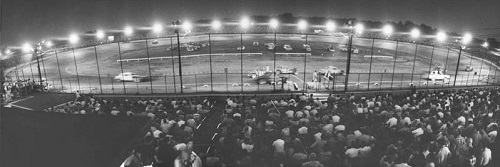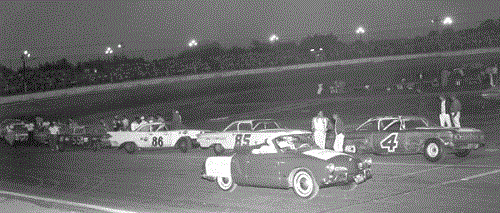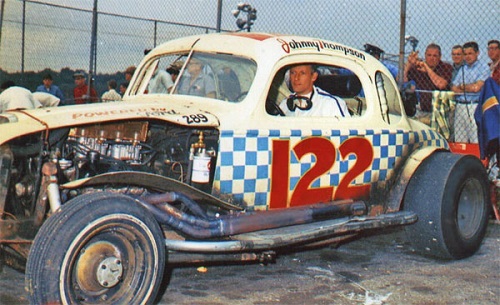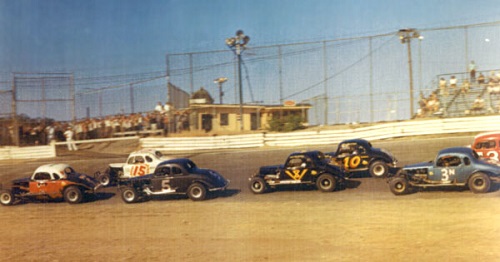NORWOOD ARENA - NORWOOD MA

Just after World War 2, a group of men speculated that Norfolk County in Massachusetts would pass legislation allowing for Pari-Mutuel gambling. Pari-Mutuel wagering was legalized by the Massachusetts Legislature in 1934 and the successful Wonderland Greyhound Park, constructed on the site of the old Wonderland Amusement Park in Revere, opened the following year. The men formed a corporation, and in
1947 acquired land on what was once a sewage treatment facility and began construction of what would be one of the best sports and greyhound dog tracks in New England. The Norwood Sports Arena incorporated in 1948 and issued stock throughout the Arena's life. The Norwood Sports Arena owners and stockholders believed the facility was a sure bet...except that the Town of Norwood or the County did not pass gambling legislation as speculated. The Sports Arena Board of Directors were forced to shift the scope of the


facility from greyhound dog racing to hold different types of sporting events, including wrestling, boxing, concerts and football to name a few. Midget auto racing had exploded onto the sports scene after World War II and the facility had a track, so it was a natural for the midgets to find their way to the Arena. Little did anyone know that this was the birth of Norwood Arena as one of the premier motorsports facilities in the country. Motorcycles and sports cars and dragsters also tried their hand at racing at the facility over the decades. On June 14, 1948 the midgets became the first race cars to turn laps on what would become one of the top 1/4 mile motorsport tracks in the country. Fifteen races were held during first season, occasionally in the rain. Attendance averaged
around 4000 fans per race night. Johnny Bernardi, won the opening night feature race. In 1949, stock cars made their first appearance at Norwood Arena under the New England Stock Car Racing Association. NESCRA was formed by local midget owner/driver Ed Stone. Like the midgets, NESCRA was a touring organization that ran several tracks weekly. These early low cost and less sophisticated stock cars (compared to the midgets) quickly grew in popularity and number. It was not uncommon for 150+ cars to sign in for a race night. The season opener in April 1949 was literally a marathon. The 24 hour race covered 3,572 laps (893 miles)


through rain and snow showers. Red Cummings and Red Keizer won the event that included a new 1949 Ford sedan. By the end of the 1949 season, Red Cummings had captured the first Norwood Arena stock car track championship. The track continued to draw big crowds as weekly racing continued strong through the 1950's. NASCAR came to the 1/4 mile speed plant in 1961. The track hosted the Yankee 500; yep, 500 fast laps around the tight little bull ring. Rex White started on the pole and led the first 125 laps. He would never see the lead again. Emanuel Zervakis grabbed the lead on lap 126 and held a tight grip on it for 123 laps. Ned Jarret would lead at the half way point, but on lap 263 Zervakis would power by back into the lead. It then became a battle between Zervakis and White. Zervakis managed to fend off all
challenges from White as therace wound down. When the checkered hankie fell Zervakis would beat White by 1/4 lap. Jarrett finished third nine laps down. Then it got interesting. A protest filed by 2nd place finisher Rex White took a week for NASCAR in Daytona Beach to settle. After reviewing the scorer sheets it was decided that Zervakis had indeed won. This would be Zervakis second (and final) Cup win. His other win would also come in 1961. NASCAR packed up and went to the next race; but unfortunately, never returned for a Cup race at Norwood Arena. Zervakis would quit driving in 1964 after he broke his knee. He went on to be one of the great car builders/owners in NASCAR in the late 1960's and throughout the 1970's. NASCAR did sanction Modified and then Late Model Sportsman races for many years. The facility still drew large crowds and car counts. They also hosted the Midget series and had Demo Derbys. Other the demo-derbys would attract over 100 cars per event. The NASCAR Late model Sportsman held races at the track through 1972 when the track closed. Norwood Arena was proud to have drivers Pete Hamilton and Don McTavish call 'home'. Hamilton drove in the Cup series for such car owners as Petty Enterprises, King Enterprises, and Cotton Owens. He garnered four Cup wins, three for Petty and one for Owens. Two wins each, at Talladega and Daytona; including the 1970 Daytona 500. McTavish was an early success and poised for a tremendously successful career until he was tragically killed at Daytona in 1969 in the 300 mile Sportsman race (now called Xfinity).
All Photos copyright and are property of their respective owners
